
When the user selects the `Filter ->' item in the View menu, the
system displays the submenu shown in Figure 46.

Figure 46: Filter submenu.
Consider for example the month view shown earlier in
Figure 22.
If the user selects `Filter Hide Appointments' in the context of that
view, the system updates the display as shown in Figure 47.
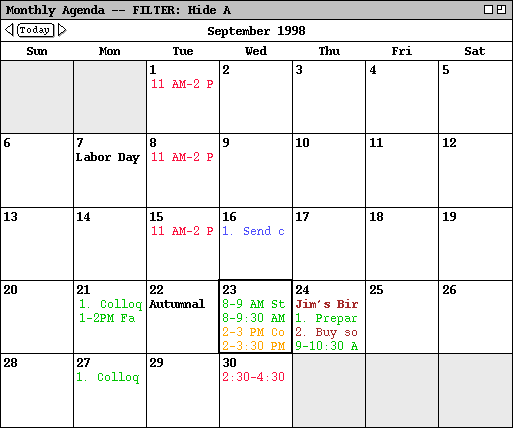
Figure 47: Month view with appointments filtered out.
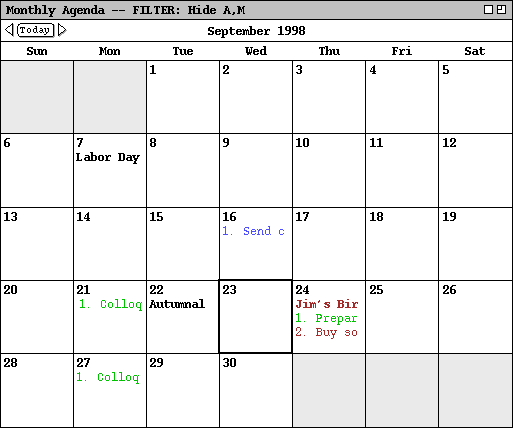
Figure 48: Month view with meetings filtered out.
Having hidden appointments and meetings, a subsequent invocation of the
`Filter' menu appears as shown in Figure 49.

Figure 49: Filter menu in `Show Appointments', `Show Meetings' state.
Showing and hiding tasks and events is analogous to meetings and appointments.
At the day level and weekly table level, the separate areas of the display are
removed when tasks and/or events are hidden. For example, Figures 50 and 51
show the results of hiding both events and tasks in the context of the daily
and weekly views shown originally in Figures
15
and
19.
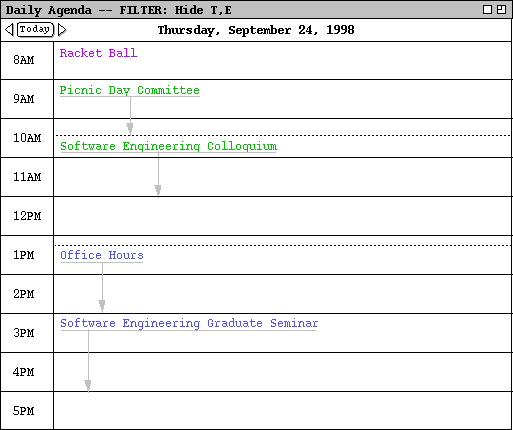
Figure 50: Events and tasks filtered out of a day view.
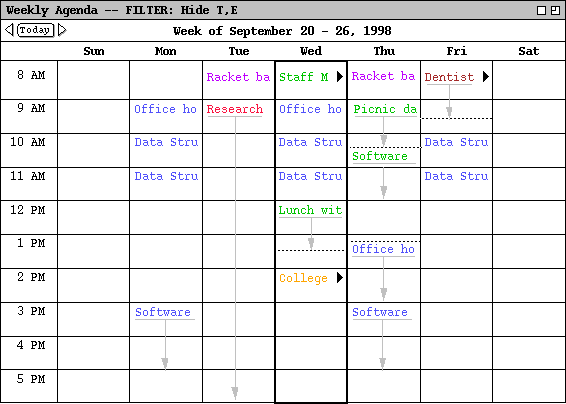
Figure 51: Events and tasks filtered out of a table-style week view.
Any or all of the commands can be in either the show or hide state. When all four commands are in the show state, all scheduled items are visible. When all four commands are in the hide state, no scheduled items are visible.
The four show/hide filtering commands apply only to calendar views at the item,
day, week, and month levels. Show/hide does not apply to year-level views
since there are no items visible at that level. Show/hide filtering also does
not apply to list views, since lists are already specialized to each kind of
item. The custom filters described in the next section apply to calendar views
as well as to lists. Operational details of show/hide and custom filtering
used in conjunction are covered in
Section .
2.3.4.1. Custom Filter Definition
The custom filtering feature of the Calendar Tool allows the user to define finer-grain filters than simply all items of a particular type. For example, the user can choose to filter out all but a particular category of item that is scheduled between some particular dates.
By default, there are no custom filters defined. Hence, when the user
initially selects the `View Filters Custom' menu item, the system
displays the submenu as shown in Figure 52.

Figure 52: Initial custom filters menu.
To create a new custom filter, the user selects the `Edit ...'
command, whereupon the system displays the filter definition dialog shown in
Figure 53.
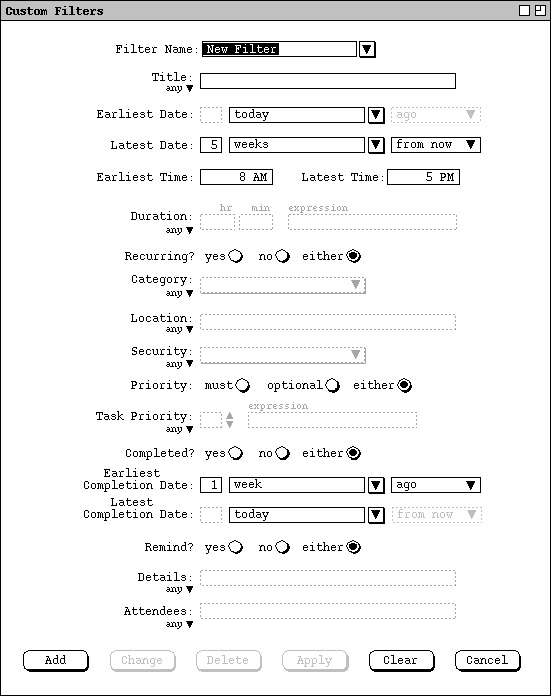
Figure 53: Filter definition dialog.
The `Filter Name' text box contains the name of the filter being defined. The initial default name is "New Filter". The user enters a chosen filter name by typing in the text box. The name for each defined filter must be unique among all other filters.
The editing fields below the filter name allow the user to define detailed filtering criteria for the display of items in calendars and lists. The criteria apply to all types of items that are currently visible, i.e., items for which the show state is on in the show/hide filter commands. The criteria apply uniformly to all calendar and list displays.
The fields in the filter definition constitute the union of components from all
four types of scheduled item. Given this, each field is not necessarily
applicable to all types of scheduled item. Table 6 defines specifically which
fields apply to which item types. (This table is a superset of
Table 5
defined for custom lists.)
| Data field | Applicable to these types of item |
| Title | all |
| Earliest Date | all |
| Latest Date | all |
| Earliest Time | appointments, meetings, tasks |
| Latest Time | appointments, meetings, tasks |
| Duration | appointments, meetings |
| Recurring? | appointments, meetings, tasks |
| Category | all |
| Location | appointments, meetings, events |
| Security | all |
| Priority | appointments, meetings |
| Task Priority | tasks |
| Completed | tasks |
| Earliest Completion Date | tasks |
| Latest Completion Date | tasks |
| Remind | appointments, meetings, tasks |
| Details | appointments, meetings, tasks |
| Attendees | meetings |
Table 6: Filter fields applicable to each type of scheduled
item.
There are a number of pulldown menus associated with the fields of the filter
definition. Figure 54 shows an the expansion of these menus.
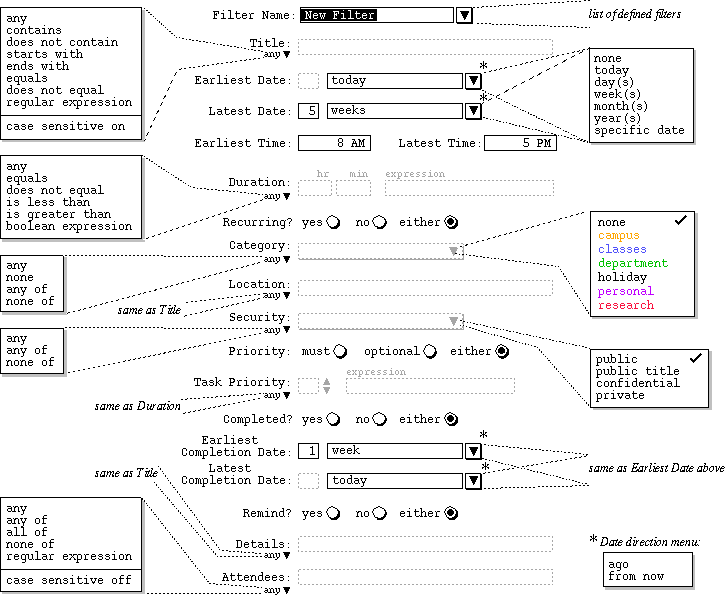
Figure 54: Expansion of Filter Definition Menus.
The `Title' field in the filter definition defines which items are visible based on the value of their titles. Immediately to the right of the `Title' label is a text box containing a pattern string for item titles. The pattern is used in conjunction with the selection in the pulldown menu below the `Title' label. Specifically:
The last item in the `Title' field menu specifies the case sensitivity
of the pattern string matching. The menu item is an on/off toggle. By
default, case sensitive matching is on for `Title' matching.
2.3.4.1.2. Earliest and Latest Date
The `Earliest Date' and `Latest Date' fields define the earliest and latest scheduled dates for which items are visible. The small text box immediately to the right of the field label is used for a numeric value in the range 1 through 99. To the right of the numeric box is a combination text box and pulldown menu that is used to define the date range. Specifically:
The `Earliest Time' and `Latest Time' fields define the
earliest and latest scheduled times for which items are visible. For
appointments ane meetings, the scheduled time is the start time; for tasks, the
scheduled time is the due time. Both fields contain time values. The default
values are 8 AM for earliest and 5 PM for latest. If the `Earliest
Time' field is empty, it is assumed to be 12:00 AM; if `Latest
Time' is empty, it is assumed to be 11:59 PM. If both fields are non-
empty, the earliest time must be less than or equal to the latest time.
2.3.4.1.4. Duration
The `Duration' field defines item visibility based on duration. A duration value is entered in hours and minutes in the two text edit boxes. If the user enters no duration value, the default is 1 hour and no minutes. The duration value is used in conjunction with a selection in the pulldown menu below the `Duration' label. Specifically:
The `Recurring?' field defines visibility based on whether a scheduled item is recurring. Specifically:
The `Category' field defines visibility based on the category of scheduled items. The pulldown menu to the right of the Category label allows the user to select one or more category values. A selected category is indicated with a check mark to the right of its name. The category-value selection is used in conjunction with the selection in the pulldown menu below the Category label. Specifically:
If exactly one category is checked in the right-side menu, then its color-coded
name appears in the text area. If two or more categories are checked, then the
name of the first category appears in the text area, suffixed with the string
"+ ...".
2.3.4.1.7. Location
The `Location' field is the same form of text box and menu combination
as the `Title' field. The entered pattern defines which items are
visible based on the value of their locations.
2.3.4.1.8. Security
The `Security' field defines visibility based on the security of scheduled items. The pulldown menu to the right of the field label allows the user to select one or more of the four security values. The security-value selection is used in conjunction with the selection in the pulldown menu below the label. Specifically:
The `Priority' field defines visibility based on the priority of scheduled items. Specifically:
The `Task Priority' field defines the visibility of tasks only, based
on their numeric priority. The small text box immediately to the right of the
field label is used for a numeric value in the range 0 through 10. To the
right of the text box are up- and down-pointing arrows that are used to
increment and decrement the numeric value. A value can also be typed directly
into the text box. The priority value is used in conjunction with the pulldown
menu below the `Task Priority' label. The items in the menu have the
same meanings as described above for the `Duration' field.
2.3.4.1.11. Completed? and Completion Dates
The `Completed?', `Earliest Completion Date', and `Latest
Completion Date' fields define the visibility of tasks based on if and
when tasks are completed. The `Completed?' field has the same three
alternatives as the `Recurring' field described above. The completion
date fields have the same text box and menu combinations as the `Earliest
Date' and `Latest Date' fields described above.
2.3.4.1.12. Remind?
The `Remind?' field defines visibility based on whether a scheduled
item has a reminder. The field has the same three alternatives as the
`Recurring?' field.
2.3.4.1.13. Details
The `Details' field is the same form of text box and menu combination
as the `Title' and `Location' fields. The entered pattern
defines which items are visible based on the value of their Details
field.
2.3.4.1.14. Attendees
The `Attendees' field defines the visibility of meetings, based on their attendees lists. Immediately to the right of the `Attendees' label is a text box containing a pattern string. The pattern is in the form of a comma-separated list of calendar user IDs or a regular expression. The pattern is used in conjunction with the the selection in the pulldown menu below the `Attendees' label. Specifically:
The last item in the `Attendees' menu specifies case sensitivity in the same manner as in the `Title' menu. The default for attendees filtering is case sensitive off.
Figure 55 shows the result of the user having defined a filter named "Fall classes" with the following criteria:
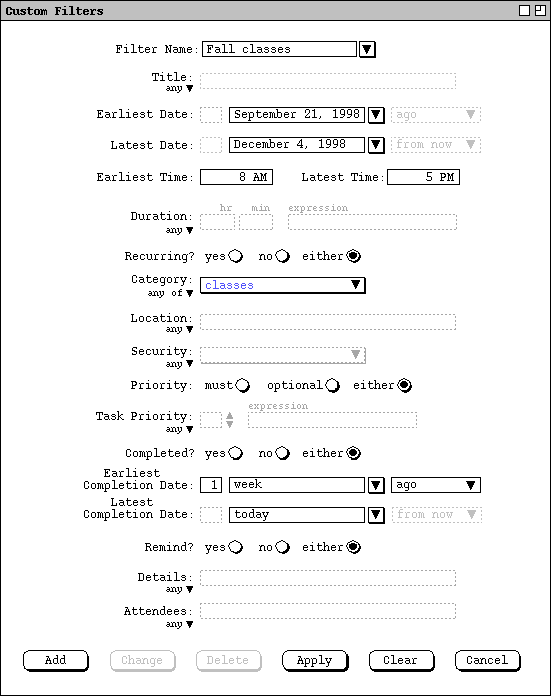
Figure 55: Fall classes custom filter.
To complete the definition of this new filter, the user presses the `Add' button at the bottom of the custom filter dialog. In response, the system adds the filter to those that are available for use. To define additional new filters, the user types new names into the `Filter Name' text box, selects the desired settings, and presses the `Add' button for each new filter to be defined.
The names of available filters appear in two contexts:

Figure 56: Menu contexts in which filter names appear.
NOTE: Finish this section by showing the effects of applying a custom
filter to some calendar and list views.